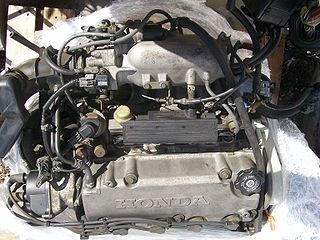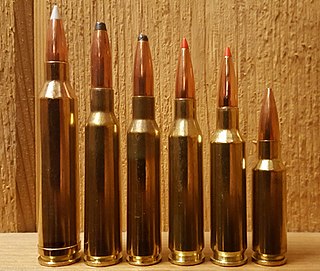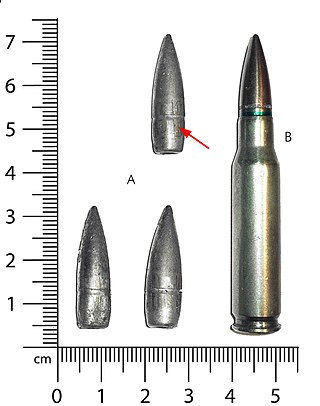
A standard-gauge railway is a railway with a track gauge of 1,435 mm. The standard gauge is also called Stephenson gauge, international gauge, UIC gauge, uniform gauge, normal gauge and European gauge in Europe, and SGR in East Africa. It is the most widely used track gauge around the world, with about 55% of the lines in the world using it. All high-speed rail lines use standard gauge except those in Russia, Finland, and Uzbekistan. The distance between the inside edges of the rails is defined to be 1,435 mm except in the United States and on some heritage British lines, where it is defined in U.S. customary/Imperial units as exactly "four feet eight and one half inches", which is equivalent to 1,435.1 mm.

The 5.56×45mm NATO is a rimless bottlenecked intermediate cartridge family developed in the late 1970s in Belgium by FN Herstal. It consists of the SS109, L110, and SS111 cartridges. On 28 October 1980, under STANAG 4172, it was standardized as the second standard service rifle cartridge for NATO forces as well as many non-NATO countries. Though they are not entirely identical, the 5.56×45mm NATO cartridge family was derived from and is dimensionally similar to the .223 Remington cartridge designed by Remington Arms in the early 1960s.

A broad-gauge railway is a railway with a track gauge broader than the 1,435 mm used by standard-gauge railways.

Paper size standards govern the size of sheets of paper used as writing paper, stationery, cards, and for some printed documents.

The following are examples of orders of magnitude for different lengths.

The .223 Remington is a rimless, bottlenecked rifle cartridge. It was developed in 1957 by Remington Arms and Fairchild Industries for the U.S. Continental Army Command of the United States Army as part of a project to create a small-caliber, high-velocity firearm. The .223 Remington is considered one of the most popular common-use cartridges and is currently used by a wide range of semi-automatic and manual-action rifles as well as handguns.

The FNSCAR is a family of gas-operated short-stroke gas piston automatic rifles developed by Belgian manufacturer FN Herstal (FN) in 2004. It is constructed with modularity for the United States Special Operations Command (SOCOM) to satisfy the requirements of the SCAR competition. This family of rifles consist of two main types. The SCAR-L, for "light", is chambered in 5.56×45mm NATO and the SCAR-H, for "heavy", is chambered in 7.62×51mm NATO. Both are available in Close Quarters Combat (CQC), Standard (STD), and Long Barrel (LB) variants.

The Honda D series inline-four cylinder engine is used in a variety of compact models, most commonly the Honda Civic, CRX, Logo, Stream, and first-generation Integra. Engine displacement ranges between 1.2 and 1.7 liters. The D Series engine is either SOHC or DOHC, and might include VTEC variable valve lift. Power ranges from 66 PS (49 kW) in the Logo to 130 PS (96 kW) in the Civic Si. D-series production commenced 1984 and ended 2005. D-series engine technology culminated with production of the D15B 3-stage VTEC (D15Z7) which was available in markets outside of the United States. Earlier versions of this engine also used a single port fuel injection system Honda called PGM-CARB, signifying the carburetor was computer controlled.

The Chrysler Hemi engines, known by the trademark Hemi or maybe more commonly HEMI, are a series of American V8 gasoline engines built by Chrysler with overhead valve hemispherical combustion chambers. Three different types of Hemi engines have been built by Chrysler for automobiles: the first from 1951 to 1958, the second from 1964 to 1971, and the third beginning in 2003. Although Chrysler is most identified with the use of "Hemi" as a marketing term, many other auto manufacturers have incorporated similar designs. The engine block and cylinder heads were cast and manufactured at Indianapolis Foundry.

Railways with a track gauge of 3 ft 6 in were first constructed as horse-drawn wagonways. The first intercity passenger railway to use 3 ft 6 in was constructed in Norway by Carl Abraham Pihl. From the mid-nineteenth century, the 3 ft 6 in gauge became widespread in the British Empire. In Africa it became known as the Cape gauge as it was adopted as the standard gauge for the Cape Government Railways in 1873, although it had already been established in Australia and New Zealand before that. It was adopted as a standard in New Zealand, South Africa, Indonesia, Japan, the Philippines, Taiwan, and Queensland in Australia.

The IndyCar Series, currently known as the NTT IndyCar Series under sponsorship, is the highest class of regional North American open-wheel single-seater formula racing cars in the United States, which has been conducted under the auspices of various sanctioning bodies since 1920 after two initial attempts in 1905 and 1916. The series is self-sanctioned by its parent company, INDYCAR, LLC., which began in 1996 as the Indy Racing League (IRL) and was created by then Indianapolis Motor Speedway owner Tony George as a competitor to Championship Auto Racing Teams (CART). In 2008, the IndyCar Series merged with CART's successor, the Champ Car World Series and the history and statistics of both series, as well as those from its predecessors, were unified.

Glock is a brand of polymer-framed, short recoil-operated, locked-breech semi-automatic pistols designed and produced by Austrian manufacturer Glock Ges.m.b.H.

The 6.5mm Creedmoor (6.5×48 mm), designated 6.5 Creedmoor by SAAMI, 6.5 Creedmoor by the C.I.P. or 6.5 CM or 6.5 CRDMR for short, is a centerfire rifle cartridge introduced by Hornady in 2007. It was developed by Hornady senior ballistics scientist Dave Emary in partnership with Dennis DeMille, the vice-president of product development at Creedmoor Sports, hence the name. The cartridge is a necked-down modification of the .30 Thompson Center.

Indian gauge is a broad track gauge of 5 ft 6 in, used in India, Pakistan, western Bangladesh, Sri Lanka, Argentina, Chile, and on BART in San Francisco, United States.

The 7.62×51mm NATO is a rimless, bottlenecked rifle cartridge. It is a standard for small arms among NATO countries.

The FN 5.7×28mm is a small-caliber, high-velocity, smokeless-powder, rebated-rim, bottlenecked centerfire cartridge designed for handgun and personal defense weapon (PDW) uses, manufactured by FN Herstal. It is similar in length to the .22 WMR (5.7×27mm) and to some degree similar also to the .22 Hornet or .22 K-Hornet. Unlike many new cartridges, it has no parent case; the complete package was developed from scratch by FN.
The aspect ratio of an image is the ratio of its width to its height, and is expressed with two numbers separated by a colon, such as 16:9, sixteen-to-nine. For the x:y aspect ratio, the image is x units wide and y units high. Common aspect ratios are 1.85:1 and 2.39:1 in cinematography, 4:3 and 16:9 in television photography, and 3:2 in still photography.












